About a year ago, state and local governments in the United States began urging residents to adjust their work, school and social lives in response to the spread of a novel coronavirus first identified in China.
Americans could agree on a few things at that early stage of the U.S. outbreak. With restaurants, stores and other public spaces around the country closing their doors, most saw COVID-19 as a serious economic threat to the nation. Most approved of their state and local officials’ initial responses to the outbreak. And they generally had confidence in hospitals and medical centers to handle the needs of those stricken with the virus.
As the pandemic wore on, however, there was less and less common ground. Indeed, the biggest takeaway about U.S. public opinion in the first year of the coronavirus outbreak may be the extent to which the decidedly nonpartisan virus met with an increasingly partisan response. Democrats and Republicans disagreed over everything from eating out in restaurants to reopening schools, even as the actual impact of the pandemic fell along different fault lines, including race and ethnicity, income, age and family structure. America’s partisan divide stood out even by international standards: No country was as politically divided over its government’s handling of the outbreak as the U.S. was in a 14-nation survey last summer.
As the COVID-19 outbreak in the U.S. extends into its second year – with more than 500,000 dead and major challenges to the nation’s economy – Pew Research Center looks back at some of the key patterns in public attitudes and experiences we observed in the first year of the crisis.
In early surveys, a sign of things to come
Our first COVID-19 survey went into the field on March 10, 2020. We interviewed nearly 9,000 Americans over the course of the next seven days – a period that saw the World Health Organization declare the virus a pandemic; President Donald Trump declare a national emergency and ban travel to the U.S. from parts of Europe; and the White House advise Americans to avoid gatherings of more than 10 people.
News about the virus was breaking so rapidly that public concern ticked up noticeably even within the weeklong field period of our survey. By mid-March, all 50 states had reported coronavirus cases. By the end of the month, the U.S. had more cases than any other country, and a majority of Americans were under some kind of stay-at-home order.

There were already some indications of the partisan divide over the virus in that first sounding. While majorities in both parties anticipated the economic problems hurtling toward the nation, Democrats and Republicans differed sharply over whether the virus was a major threat to the health of the U.S. population. About six-in-ten Democrats and Democratic-leaning independents (59{bf9f37f88ebac789d8dc87fbc534dfd7d7e1a7f067143a484fc5af4e53e0d2c5}) said it was, compared with only a third of Republicans and GOP-leaning independents. That 26 percentage point gap would grow to around 40 points as spring turned to summer and then fall.
Other divides also became apparent in that first survey. They included heightened health concerns among Black and Hispanic Americans, as well as greater economic concerns among workers with lower incomes and less formal schooling. Both would become recurring themes throughout the pandemic and the severe recession it brought on.
Overall, our first polling on COVID-19 showed that the public had mixed expectations about how the outbreak would play out in the months ahead. That wasn’t necessarily a surprise, given that most Americans had little or no experience with a pandemic. In mid-March, only around a third of U.S. adults (36{bf9f37f88ebac789d8dc87fbc534dfd7d7e1a7f067143a484fc5af4e53e0d2c5}) expected the virus to pose a major threat to the day-to-day life of their community.

By late March and early April, the mood had clearly changed. Two-thirds of Americans – including majorities in both parties and across all major demographic groups – saw COVID-19 as a significant crisis at that time. Large majorities saw a recession or depression coming, predicted the pandemic would last more than six months, said the worst was still to come and anticipated that there could be at least some disruptions to Americans’ ability to vote in the presidential election in November. All of those things would turn out to be true.
A trust gap over key sources of information
The arrival of a first-in-a-lifetime pandemic created a sudden need for average people to find and process large amounts of complicated and rapidly evolving information. Americans turned to many different sources for that information, but two commonly cited ones, the White House and the news media, brought out especially sharp partisan differences in attitudes.
In late March, views of how Trump was handling the outbreak were already starkly split along party lines. Around eight-in-ten Republicans (83{bf9f37f88ebac789d8dc87fbc534dfd7d7e1a7f067143a484fc5af4e53e0d2c5}) said the president was doing an excellent or good job, including 47{bf9f37f88ebac789d8dc87fbc534dfd7d7e1a7f067143a484fc5af4e53e0d2c5} who said he was doing an excellent job. A nearly identical share of Democrats (81{bf9f37f88ebac789d8dc87fbc534dfd7d7e1a7f067143a484fc5af4e53e0d2c5}) rated his response as only fair or poor, including 56{bf9f37f88ebac789d8dc87fbc534dfd7d7e1a7f067143a484fc5af4e53e0d2c5} who said it was poor.
In early April, around two-thirds of Republicans (66{bf9f37f88ebac789d8dc87fbc534dfd7d7e1a7f067143a484fc5af4e53e0d2c5}) said Trump was quick to take the major steps needed in response to international reports of the outbreak; 92{bf9f37f88ebac789d8dc87fbc534dfd7d7e1a7f067143a484fc5af4e53e0d2c5} of Democrats said he was too slow off the mark. In the same survey, 69{bf9f37f88ebac789d8dc87fbc534dfd7d7e1a7f067143a484fc5af4e53e0d2c5} of Republicans said Trump was accurately characterizing the severity of the COVID-19 situation; an even larger share of Democrats (77{bf9f37f88ebac789d8dc87fbc534dfd7d7e1a7f067143a484fc5af4e53e0d2c5}) said he was making it seem better than it really was. Fall came but the partisan divide remained: In early September, around eight-in-ten Republicans (79{bf9f37f88ebac789d8dc87fbc534dfd7d7e1a7f067143a484fc5af4e53e0d2c5}) said the president was giving the country the right message on the virus; a bigger proportion of Democrats (90{bf9f37f88ebac789d8dc87fbc534dfd7d7e1a7f067143a484fc5af4e53e0d2c5}) said he was delivering the wrong message.
If views were partisan when it came to the president, they were only slightly less so when it came to the news media. In mid-March, 89{bf9f37f88ebac789d8dc87fbc534dfd7d7e1a7f067143a484fc5af4e53e0d2c5} of all Americans said they were following news about the outbreak very or fairly closely. But Democrats were already much more likely than Republicans to say the media had covered the pandemic at least somewhat well (80{bf9f37f88ebac789d8dc87fbc534dfd7d7e1a7f067143a484fc5af4e53e0d2c5} vs. 59{bf9f37f88ebac789d8dc87fbc534dfd7d7e1a7f067143a484fc5af4e53e0d2c5}), while Republicans were more likely than Democrats to say the media had exaggerated the risks of the outbreak (76{bf9f37f88ebac789d8dc87fbc534dfd7d7e1a7f067143a484fc5af4e53e0d2c5} vs. 49{bf9f37f88ebac789d8dc87fbc534dfd7d7e1a7f067143a484fc5af4e53e0d2c5}).

As the pandemic continued, divisions over the media became more apparent. In late April, majorities of Democrats said the news coverage of the outbreak was getting them the information they needed (73{bf9f37f88ebac789d8dc87fbc534dfd7d7e1a7f067143a484fc5af4e53e0d2c5}), was largely accurate (66{bf9f37f88ebac789d8dc87fbc534dfd7d7e1a7f067143a484fc5af4e53e0d2c5}), worked for the benefit of the public (66{bf9f37f88ebac789d8dc87fbc534dfd7d7e1a7f067143a484fc5af4e53e0d2c5}) and helped the country (63{bf9f37f88ebac789d8dc87fbc534dfd7d7e1a7f067143a484fc5af4e53e0d2c5}). Fewer than half of Republicans agreed with each statement.
By September, around eight-in-ten Democrats (81{bf9f37f88ebac789d8dc87fbc534dfd7d7e1a7f067143a484fc5af4e53e0d2c5}) continued to say the media were doing very or somewhat well covering the outbreak, but the proportion of Republicans who agreed had fallen below half (45{bf9f37f88ebac789d8dc87fbc534dfd7d7e1a7f067143a484fc5af4e53e0d2c5}).
On many subjects related to the coronavirus, public attitudes differed not only by political party, but within each party, depending on where people turned for news and information. Republicans who relied on Trump and the White House for COVID-19 news, for example, were consistently more likely than Republicans who turned elsewhere for news to rate Trump’s response highly – and the media’s response poorly.
Meanwhile, with the perceived trustworthiness of information from both the White House and the media deeply divided along partisan lines, Americans expressed concerns about the proliferation of misinformation.
As early as mid-March, around half of Americans (48{bf9f37f88ebac789d8dc87fbc534dfd7d7e1a7f067143a484fc5af4e53e0d2c5}) said they had seen at least some information about COVID-19 that seemed completely made up, on subjects ranging from the origin of the virus to its risks and potential cures. In early June, sizable shares in both parties – but especially Republicans – said they were finding it harder to tell what was true and what was false about the outbreak. And conspiracy theories began to gain a foothold: In the same June survey, a quarter of U.S. adults saw at least some truth in the theory that powerful people had intentionally planned the outbreak. Republicans were about twice as likely as Democrats (34{bf9f37f88ebac789d8dc87fbc534dfd7d7e1a7f067143a484fc5af4e53e0d2c5} vs. 18{bf9f37f88ebac789d8dc87fbc534dfd7d7e1a7f067143a484fc5af4e53e0d2c5}) to say the claim was probably or definitely true.
Divisions over shutdowns, social distancing and masks
It may seem hard to believe today, but in late March 2020, there was strong bipartisan support for a variety of government-imposed shutdown measures. At the time, broad majorities in both parties supported restricting international travel to the U.S., canceling sports and entertainment events, closing K-12 schools, asking people to avoid gatherings of more than 10 people and halting indoor dining at restaurants.
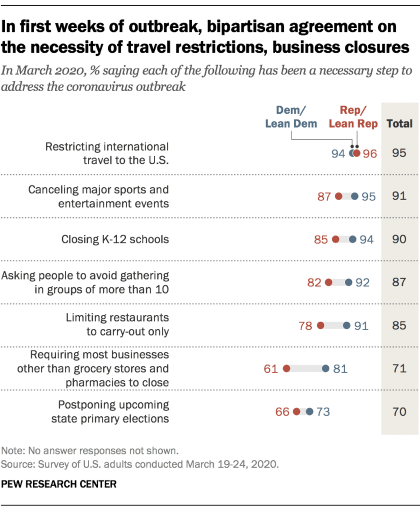
The restrictions didn’t always wear well over time, particularly as governors and other leaders tried to navigate both public health and economic considerations. By early April, around eight-in-ten Democrats (81{bf9f37f88ebac789d8dc87fbc534dfd7d7e1a7f067143a484fc5af4e53e0d2c5}) said their greater concern was that state-level restrictions on public activity would be lifted too quickly, a view shared by only around half of Republicans (51{bf9f37f88ebac789d8dc87fbc534dfd7d7e1a7f067143a484fc5af4e53e0d2c5}). That 30-point difference would grow to 40 points by early May.
In addition to differences over government restrictions, Democrats were more likely than Republicans to say that social distancing – or even personal actions more broadly – made a big difference in slowing the outbreak. Around seven-in-ten Democrats (69{bf9f37f88ebac789d8dc87fbc534dfd7d7e1a7f067143a484fc5af4e53e0d2c5}) said in early May that social distancing measures were helping reduce the spread of the virus a lot, compared with around half of Republicans (49{bf9f37f88ebac789d8dc87fbc534dfd7d7e1a7f067143a484fc5af4e53e0d2c5}). In mid-June, 73{bf9f37f88ebac789d8dc87fbc534dfd7d7e1a7f067143a484fc5af4e53e0d2c5} of Democrats said the actions of ordinary Americans affected the spread of the virus a great deal, compared with 44{bf9f37f88ebac789d8dc87fbc534dfd7d7e1a7f067143a484fc5af4e53e0d2c5} of Republicans.

Partisans also differed over the reasons behind the rising case counts in the summer of 2020. Most Republicans accepted Trump’s claim that the growing number of cases was primarily a result of increased testing, rather than a combination of testing and a real increase in infections. Eight-in-ten Democrats pointed to more infections, not just more testing.
And then there was the subject of masks. While surveys consistently showed that a majority of Americans reported wearing masks in stores and other businesses, divisions by party stood out. In early June, 76{bf9f37f88ebac789d8dc87fbc534dfd7d7e1a7f067143a484fc5af4e53e0d2c5} of Democrats said they had worn a mask in stores all or most of the time in the past month, compared with 53{bf9f37f88ebac789d8dc87fbc534dfd7d7e1a7f067143a484fc5af4e53e0d2c5} of Republicans.
Mask-wearing became more widespread in both parties as time passed, particularly as Trump donned a mask in public for the first time and the virus moved from more Democratic parts of the country to more Republican ones. But an analysis of volunteered survey responses in September underscored the ongoing differences in opinion over face coverings:
“I live in Missouri in a smaller town, less than 5K. Everyone thinks it’s made up, no one wears masks or social distances. […] I don’t feel safe or protected by my managers but I also can’t say anything because I need the job.” –Woman, 36
“I wear [a mask] for at least 8 hours a day along with a face shield, gloves and lab coat. I see approximately 100 patients a day and when I hear people complain about having to wear it for 20 minutes or those who refuse to wear it, I just have to scream silently inside.” –Woman, 59
“I have chronic asthma so I am fearful of being exposed to the coronavirus. It makes me extremely angry to go out and see people not wearing masks or keeping social distance. And my intense dislike of Trump has grown because he lies about the coronavirus and there is blood on his hands. His lack of telling the truth about the coronavirus and his attempt to use the public health systems of the U.S. for his own political ends are the equivalent of murdering thousands of people.” –Man, 73
“Forced to wear masks for a virus that killed less than 10,000 people, I am more likely to be murdered in Kansas City than catch COVID there.” –Man, 28
“The entire unnecessary shutdown of the country got my husband furloughed for 9 weeks, more government overreach with mask orders, people are just so terrified to live it’s disgusting, so the ones of us like me who aren’t scared get treated like we are awful people” –Woman, 31
“Being forced to wear a completely useless mask when going into businesses. I have bad allergies and can’t breathe well. The CDC has reported that the masks are useless, which to me indicates they are virtue signaling items and are being used to control people.” –Woman, 70
In the bigger picture, the disputes over shutdowns, social distancing and masks pointed to partisan differences over whether the country should place greater emphasis on stopping the spread of the virus or on restarting the economy.
The vast majority of Democrats (94{bf9f37f88ebac789d8dc87fbc534dfd7d7e1a7f067143a484fc5af4e53e0d2c5}) said in the summer that the more effective way to fix the economy was to reduce infections to a level where more people would feel comfortable going to stores, schools and other workplaces. Republicans were divided: Half said, for the sake of the economy, these kinds of places should open up even without a significant reduction in infections.

Far-reaching changes to the routines of daily life
Pandemic-related closures forced Americans to make wholesale changes in their everyday lives, from the way they attended religious services to the way they connected with friends and family, attended exercise classes, shopped for groceries and much more. Many of these activities moved online – so much so that 53{bf9f37f88ebac789d8dc87fbc534dfd7d7e1a7f067143a484fc5af4e53e0d2c5} of adults said in April that the internet had been essential to them during the first weeks of the outbreak.

Even personal living arrangements changed for a sizable share of the public: In a June survey, 22{bf9f37f88ebac789d8dc87fbc534dfd7d7e1a7f067143a484fc5af4e53e0d2c5} of U.S. adults said they or someone they knew had moved because of the pandemic.
While people from all walks of life were personally affected, there were persistent partisan divides in Americans’ comfort level with a range of daily activities. In the summer of 2020, Republicans were more likely than Democrats to say they were comfortable going out to the grocery store, visiting with family or friends inside their home, going to a hair salon or barbershop, eating out in a restaurant, attending an indoor sports event or concert, and attending a crowded party. On some measures, Republicans became much more comfortable as the pandemic wore on, while Democrats remained more hesitant. In June, around two-thirds of Republicans (65{bf9f37f88ebac789d8dc87fbc534dfd7d7e1a7f067143a484fc5af4e53e0d2c5}) said they would feel comfortable eating out at a restaurant, up from 29{bf9f37f88ebac789d8dc87fbc534dfd7d7e1a7f067143a484fc5af4e53e0d2c5} in March, even as Democrats remained mostly uncomfortable with the idea.

Back-to-school season brought more partisan divides. In late July, 36{bf9f37f88ebac789d8dc87fbc534dfd7d7e1a7f067143a484fc5af4e53e0d2c5} of Republicans but only 6{bf9f37f88ebac789d8dc87fbc534dfd7d7e1a7f067143a484fc5af4e53e0d2c5} of Democrats said K-12 schools in their area should offer in-person classes five days a week; 41{bf9f37f88ebac789d8dc87fbc534dfd7d7e1a7f067143a484fc5af4e53e0d2c5} of Democrats but only 13{bf9f37f88ebac789d8dc87fbc534dfd7d7e1a7f067143a484fc5af4e53e0d2c5} of Republicans favored online classes five days a week. When asked about the factors local school districts should take into consideration when deciding whether to reopen, Democrats focused more on the possible health risks to students and teachers; Republicans focused more on the harms caused by the lack of in-person instruction, such as students falling behind and parents not being able to work with their children at home.
As the presidential election approached, Americans differed not only over whom they planned to vote for, but how they planned to cast their ballots. In a late summer survey, most registered voters who supported Joe Biden (58{bf9f37f88ebac789d8dc87fbc534dfd7d7e1a7f067143a484fc5af4e53e0d2c5}) said they would vote by mail – taking advantage of an expansion of that option due to the pandemic – while roughly the same share of Trump supporters (60{bf9f37f88ebac789d8dc87fbc534dfd7d7e1a7f067143a484fc5af4e53e0d2c5}) said they would vote in person on Election Day itself.
The holiday season brought further partisan divides. With health authorities cautioning against holiday travel, more than half of Americans (57{bf9f37f88ebac789d8dc87fbc534dfd7d7e1a7f067143a484fc5af4e53e0d2c5}) said they had changed their Thanksgiving plans a great deal or some due to the pandemic. But Democrats were far more likely than Republicans to say they had done so (70{bf9f37f88ebac789d8dc87fbc534dfd7d7e1a7f067143a484fc5af4e53e0d2c5} vs. 44{bf9f37f88ebac789d8dc87fbc534dfd7d7e1a7f067143a484fc5af4e53e0d2c5}).
Unique challenges for Black, Hispanic and Asian Americans
The pandemic didn’t just expose partisan divides at nearly every turn. It also revealed stark racial and ethnic differences in health outcomes, financial duress and personal experiences with discrimination.
More than half a million Americans died of COVID-19 in the first year of the outbreak alone, with the death toll sometimes exceeding 4,000 people a day. But fatality rates were much higher among Black, Hispanic and other racial and ethnic minority groups than among White Americans. Not surprisingly, Black and Hispanic survey respondents were also consistently more likely than White adults to voice health concerns over the virus and to say they personally knew someone who had suffered serious health consequences because of it.
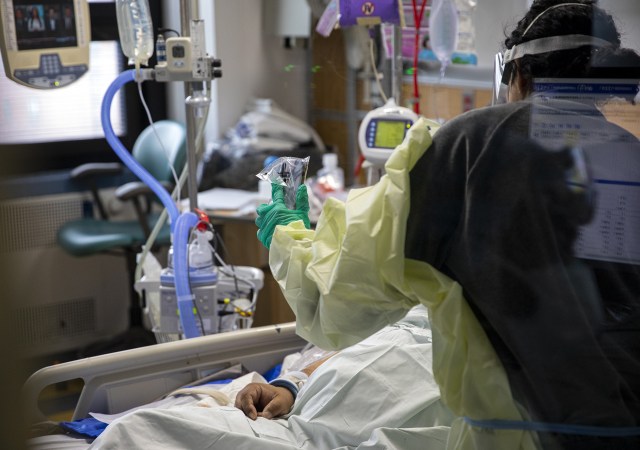
Already in April, around a quarter of Black Americans (27{bf9f37f88ebac789d8dc87fbc534dfd7d7e1a7f067143a484fc5af4e53e0d2c5}) said they knew someone who had been hospitalized or died due to COVID-19. That figure would rise to 34{bf9f37f88ebac789d8dc87fbc534dfd7d7e1a7f067143a484fc5af4e53e0d2c5} by May, 57{bf9f37f88ebac789d8dc87fbc534dfd7d7e1a7f067143a484fc5af4e53e0d2c5} by August, 71{bf9f37f88ebac789d8dc87fbc534dfd7d7e1a7f067143a484fc5af4e53e0d2c5} by November and 78{bf9f37f88ebac789d8dc87fbc534dfd7d7e1a7f067143a484fc5af4e53e0d2c5} by February 2021. By then, around three-quarters of Hispanic Americans (74{bf9f37f88ebac789d8dc87fbc534dfd7d7e1a7f067143a484fc5af4e53e0d2c5}) also said they knew someone who had died or been hospitalized, even as White and Asian Americans remained less likely to say so.
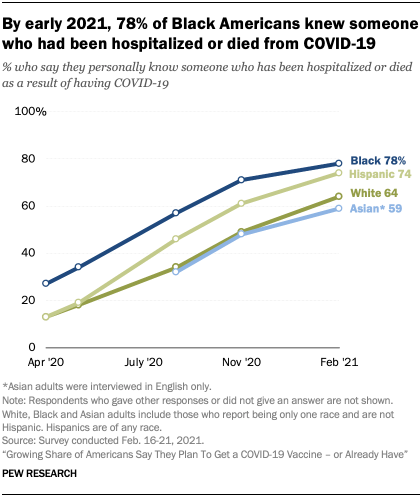
The rapid development of new vaccines was welcome news in the fight against COVID-19, but one that highlighted additional racial and ethnic differences. In surveys in May, September, November and February 2021, a majority of Americans said they would definitely or probably get a vaccine if one were available, but Black adults were consistently less likely than other adults to say this.
Besides the health disparities it exposed, the pandemic also led to greater financial hardship among Black and Hispanic adults, who were already more likely than other Americans (on average) to have lower incomes long before the outbreak began.
Hispanic Americans were especially affected by the downturn, often because they worked in the industries hit hardest by the recession. Just after the outbreak began in March, 49{bf9f37f88ebac789d8dc87fbc534dfd7d7e1a7f067143a484fc5af4e53e0d2c5} of Hispanics – compared with 33{bf9f37f88ebac789d8dc87fbc534dfd7d7e1a7f067143a484fc5af4e53e0d2c5} of Americans overall – said they or someone in their household had taken a pay cut or lost their job. By April, 61{bf9f37f88ebac789d8dc87fbc534dfd7d7e1a7f067143a484fc5af4e53e0d2c5} of Hispanics – versus 43{bf9f37f88ebac789d8dc87fbc534dfd7d7e1a7f067143a484fc5af4e53e0d2c5} of the overall public – said they or someone in their household had had one of these things happen to them.
Meanwhile, amid talk of the “China virus” from Trump and others, discrimination became another cause for concern during the pandemic, especially for Asian and Black Americans. In June, around four-in-ten Asian (39{bf9f37f88ebac789d8dc87fbc534dfd7d7e1a7f067143a484fc5af4e53e0d2c5}) and Black (38{bf9f37f88ebac789d8dc87fbc534dfd7d7e1a7f067143a484fc5af4e53e0d2c5}) adults said people had acted as if they were uncomfortable around them because of their race or ethnicity since the outbreak began. Asian and Black adults were also more likely to say they had been subject to slurs or jokes and to worry that someone might threaten or physically attack them because of their race or ethnicity.
A recession that hit lower-income workers hardest
The recession brought on by COVID-19 arrived with exceptional speed and severity: Unemployment rose more quickly in the first three months of the pandemic than it did in two years of the Great Recession.

But the downturn did not affect all Americans equally. It had an especially hard impact on lower-income workers, who often worked in jobs that could not be done remotely. A Pew Research Center analysis found that 90{bf9f37f88ebac789d8dc87fbc534dfd7d7e1a7f067143a484fc5af4e53e0d2c5} of the total decrease in U.S. employment between February and March of last year – 2.6 million out of 2.9 million lost jobs – arose from positions that could not be teleworked.
By April, 52{bf9f37f88ebac789d8dc87fbc534dfd7d7e1a7f067143a484fc5af4e53e0d2c5} of lower-income Americans said they or someone in their household had lost their job or taken a pay cut, compared with 42{bf9f37f88ebac789d8dc87fbc534dfd7d7e1a7f067143a484fc5af4e53e0d2c5} of middle-income adults and 32{bf9f37f88ebac789d8dc87fbc534dfd7d7e1a7f067143a484fc5af4e53e0d2c5} those in the upper income tier. That translated into greater difficulties paying bills: 53{bf9f37f88ebac789d8dc87fbc534dfd7d7e1a7f067143a484fc5af4e53e0d2c5} of lower-income adults said they couldn’t pay some of their bills that month, far higher than the proportion of middle- and upper-income Americans who said the same (26{bf9f37f88ebac789d8dc87fbc534dfd7d7e1a7f067143a484fc5af4e53e0d2c5} and 11{bf9f37f88ebac789d8dc87fbc534dfd7d7e1a7f067143a484fc5af4e53e0d2c5}, respectively).
Lower-income people were also much less likely to have emergency funds set aside to help them withstand the recession. While three-quarters of high-income Americans and around half (48{bf9f37f88ebac789d8dc87fbc534dfd7d7e1a7f067143a484fc5af4e53e0d2c5}) of middle-income adults said in April that they had rainy day funds to cover three months of expenses, the same was true of only around a quarter (23{bf9f37f88ebac789d8dc87fbc534dfd7d7e1a7f067143a484fc5af4e53e0d2c5}) of those in the lowest income tier.
The stimulus checks that Congress approved in late March 2020 were an important relief measure – and one of the few policy steps that drew bipartisan support – but Americans didn’t use the money in the same ways. A large majority (71{bf9f37f88ebac789d8dc87fbc534dfd7d7e1a7f067143a484fc5af4e53e0d2c5}) of lower-income adults who said they were expecting a government payment said they would use most of the money to pay bills or for some other essential need. Upper-income Americans were more likely to say they would put the money into savings, use it to pay off debt or do something else with it.
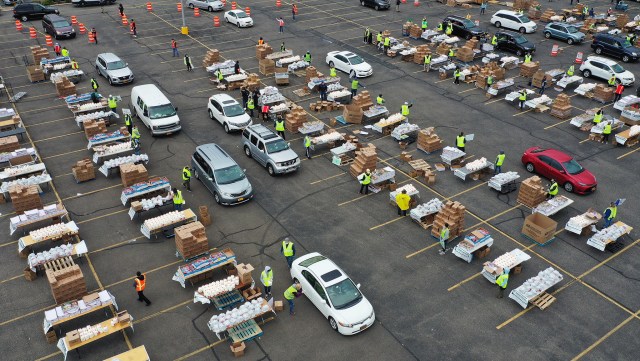
Many lower-income Americans turned to other sources of financial help. In an August survey, 44{bf9f37f88ebac789d8dc87fbc534dfd7d7e1a7f067143a484fc5af4e53e0d2c5} said they had used money from their savings or retirement accounts to pay bills, while 35{bf9f37f88ebac789d8dc87fbc534dfd7d7e1a7f067143a484fc5af4e53e0d2c5} said they had borrowed money from friends or family, 35{bf9f37f88ebac789d8dc87fbc534dfd7d7e1a7f067143a484fc5af4e53e0d2c5} said they had gotten food from a food bank or similar organization and 37{bf9f37f88ebac789d8dc87fbc534dfd7d7e1a7f067143a484fc5af4e53e0d2c5} said they had received government food assistance. Middle- and higher-income adults were far less likely to take each of those steps.
Given these and many other challenges, it may not be a surprise that lower-income Americans were among the likeliest groups to report high levels of psychological distress during the pandemic.
Difficulties for young people – and parents
Another clear dividing line in the pandemic was age. A March 2020 survey found that while older Americans worried more about the health effects of the virus, younger Americans expressed more concern about its economic consequences, particularly since many of them were employed in service-sector jobs that were at higher risk from virus-related layoffs.
By early April, those risks were borne out: More than half (54{bf9f37f88ebac789d8dc87fbc534dfd7d7e1a7f067143a484fc5af4e53e0d2c5}) of Americans ages 18 to 29 said they or someone in their household had taken a pay cut or lost their job because of the outbreak, considerably higher than the proportion of all Americans who said the same thing (43{bf9f37f88ebac789d8dc87fbc534dfd7d7e1a7f067143a484fc5af4e53e0d2c5}).
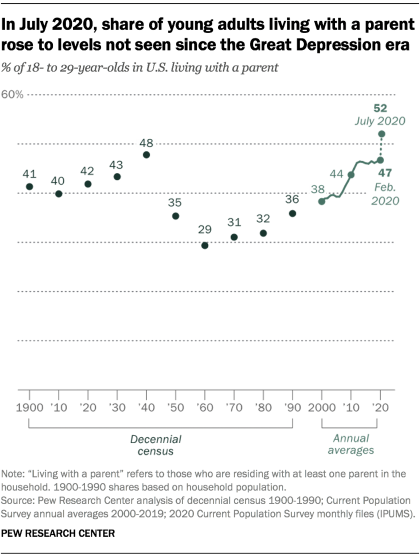
For those young adults who were enrolled in college, the pandemic profoundly affected their experience. And early evidence suggested that the financial fallout from the COVID-19 recession might derail some students’ future plans to attend college: Applications for admission and financial aid in 2021 declined, particularly among economically disadvantaged youth.
With many jobs disappearing and the college experience altered, the share of young adults who were neither employed nor enrolled in school soared in the first few months of the pandemic. Between March and June 2020, the share of 16- to 24-year-olds who were “disconnected” from both work and school rose from 12{bf9f37f88ebac789d8dc87fbc534dfd7d7e1a7f067143a484fc5af4e53e0d2c5} to 28{bf9f37f88ebac789d8dc87fbc534dfd7d7e1a7f067143a484fc5af4e53e0d2c5}, the highest rate ever recorded for the month of June.
The difficult landscape forced many young adults to move elsewhere. Those ages 18 to 29 were the most likely group to say they had permanently or temporarily moved due to the pandemic. In many cases, they went back to a parent’s home: By July, a 52{bf9f37f88ebac789d8dc87fbc534dfd7d7e1a7f067143a484fc5af4e53e0d2c5} majority of adults under the age of 30 were living with at least one parent, up from 47{bf9f37f88ebac789d8dc87fbc534dfd7d7e1a7f067143a484fc5af4e53e0d2c5} in February and the highest percentage since the Great Depression.
While young people faced many challenges during the pandemic, so did parents. In April 2020, with schools around the country closed, roughly two-thirds (64{bf9f37f88ebac789d8dc87fbc534dfd7d7e1a7f067143a484fc5af4e53e0d2c5}) of parents with children in elementary, middle or high school said they were at least somewhat worried about their kids falling behind because of the disruptions caused by the outbreak. By October, even as some schools had returned to in-person learning, those concerns had not diminished. At both points in time, lower-income parents were much more worried than middle- and upper-income parents.
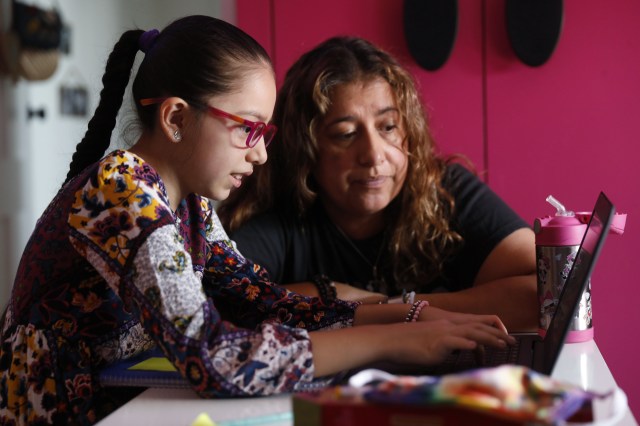
Working parents with young children at home faced particular difficulties as they tried to balance their own job responsibilities with their children in tow.
In the early stages of the outbreak, most working parents with kids younger than 12 at home (62{bf9f37f88ebac789d8dc87fbc534dfd7d7e1a7f067143a484fc5af4e53e0d2c5}) said it was very or somewhat easy to handle child care responsibilities under the new circumstances. That changed by the fall: In October, 52{bf9f37f88ebac789d8dc87fbc534dfd7d7e1a7f067143a484fc5af4e53e0d2c5} of these parents said it was very or somewhat difficult to handle child care. Working moms were more likely than working dads to say it was hard to deal with these responsibilities. They were also more likely than working dads to face a variety of professional challenges during the outbreak, including feeling as though they couldn’t give 100{bf9f37f88ebac789d8dc87fbc534dfd7d7e1a7f067143a484fc5af4e53e0d2c5} at work because they were balancing their work and parenting duties.

Single moms, in particular, left the workforce in large numbers. Around two-thirds (67.4{bf9f37f88ebac789d8dc87fbc534dfd7d7e1a7f067143a484fc5af4e53e0d2c5}) of unpartnered mothers with children younger than 18 at home were employed and on the job in September 2020, down from 76.1{bf9f37f88ebac789d8dc87fbc534dfd7d7e1a7f067143a484fc5af4e53e0d2c5} a year earlier. That 9-point decrease was the biggest among all groups of parents, partnered or not, with especially sharp declines among Black and Hispanic single moms.
A pandemic election, a change in administration and what comes next
The coronavirus outbreak’s effect on the 2020 presidential election would be hard to overstate. The pandemic changed the way tens of millions of Americans cast their ballots and almost certainly played a role in estimated turnout among eligible voters soaring to its highest level in 120 years. Every state and the District of Columbia saw turnout rise from 2016 levels, with many of the biggest increases occurring in places that held their elections entirely or mostly by mail.
The pandemic loomed large as a voting issue, too, albeit one that starkly divided supporters of the two major candidates. In a survey a month before the election, 82{bf9f37f88ebac789d8dc87fbc534dfd7d7e1a7f067143a484fc5af4e53e0d2c5} of Biden supporters said COVID-19 would be very important to their vote, a view shared by just 24{bf9f37f88ebac789d8dc87fbc534dfd7d7e1a7f067143a484fc5af4e53e0d2c5} of Trump supporters. After the election, Biden supporters again overwhelmingly pointed to the outbreak – and, more specifically, Trump’s handling of it – as a major reason for their candidate’s victory, even as few Trump supporters agreed (86{bf9f37f88ebac789d8dc87fbc534dfd7d7e1a7f067143a484fc5af4e53e0d2c5} vs. 18{bf9f37f88ebac789d8dc87fbc534dfd7d7e1a7f067143a484fc5af4e53e0d2c5}, respectively). Majorities in both camps did agree that the expanded availability of early and mail-in voting was a major reason for the outcome.
When Biden took over from Trump in January, he quickly struck a different tone on COVID-19, warning that the nation’s death toll would climb in the months ahead and that the situation would “get worse before it gets better.” The new president’s first legislative priority was to try to push a $1.9 trillion relief plan through Congress in response to the ongoing public health and economic crisis. He simultaneously vowed that his administration would deliver 100 million vaccinations in its first 100 days in office.
Surveys in early 2021 showed that Americans continued to see the pandemic as a pressing issue in the months ahead. In January, around eight-in-ten Americans – including majorities in both parties – said strengthening the economy (80{bf9f37f88ebac789d8dc87fbc534dfd7d7e1a7f067143a484fc5af4e53e0d2c5}) and dealing with the outbreak (78{bf9f37f88ebac789d8dc87fbc534dfd7d7e1a7f067143a484fc5af4e53e0d2c5}) should be a top policy priority for Biden and the new Congress, higher than the share who said the same about all other issues asked about in the survey. In early February, seven-in-ten adults – again including majorities of Democrats and Republicans – said reducing the spread of infectious diseases should be a top long-term foreign policy goal for the nation.
While the economy began to show some signs of recovery in early 2021, the lasting imprint of the COVID-19 recession was coming into clearer view. In January, about half of non-retired adults (51{bf9f37f88ebac789d8dc87fbc534dfd7d7e1a7f067143a484fc5af4e53e0d2c5}) said the economic impact of the outbreak would make it harder for them to achieve their long-term financial goals. That included 62{bf9f37f88ebac789d8dc87fbc534dfd7d7e1a7f067143a484fc5af4e53e0d2c5} of those living in a household that had experienced job or wage losses during the pandemic.
There were also signs of rising public dissatisfaction with some aspects of the nation’s response to the outbreak. In mid-February, a declining share of Americans said public health officials and state and local elected officials were doing an excellent or good job responding to the outbreak, and around half (51{bf9f37f88ebac789d8dc87fbc534dfd7d7e1a7f067143a484fc5af4e53e0d2c5}) said new variants of the coronavirus would lead to a major setback in the country’s efforts to control the disease.

At the same time, Americans expressed optimism on other fronts, including in their views of the new administration and the growing availability of vaccines. More than half the public (56{bf9f37f88ebac789d8dc87fbc534dfd7d7e1a7f067143a484fc5af4e53e0d2c5}) said in mid-February that Biden’s plans and policies would improve the nation’s response to the virus, and around three-quarters expected the national economy to improve a lot (51{bf9f37f88ebac789d8dc87fbc534dfd7d7e1a7f067143a484fc5af4e53e0d2c5}) or a little (25{bf9f37f88ebac789d8dc87fbc534dfd7d7e1a7f067143a484fc5af4e53e0d2c5}) if a large majority of Americans got the COVID-19 vaccine.
Willingness to get the vaccine was on the rise, too, including among people who had previously expressed much more skepticism. In the mid-February survey, around seven-in-ten Americans (69{bf9f37f88ebac789d8dc87fbc534dfd7d7e1a7f067143a484fc5af4e53e0d2c5}) said they would definitely or probably get a vaccine or that they had already gotten at least the first dose. That was up from 60{bf9f37f88ebac789d8dc87fbc534dfd7d7e1a7f067143a484fc5af4e53e0d2c5} who said they would definitely or probably get the vaccine in November 2020. A majority of Black Americans (61{bf9f37f88ebac789d8dc87fbc534dfd7d7e1a7f067143a484fc5af4e53e0d2c5}) said they planned to get inoculated or had already been vaccinated, up from just 42{bf9f37f88ebac789d8dc87fbc534dfd7d7e1a7f067143a484fc5af4e53e0d2c5} three months earlier.
Title photos, from left to right: Steve Pfost/Newsday via Getty Images; James Cavallini/BSIP/Universal Images Group via Getty Images; Kent Nishimura/Los Angeles Times via Getty Images; Alex Wong/Getty Images; Robert Gauthier/Los Angeles Times via Getty Images. Photo illustration by Pew Research Center.
